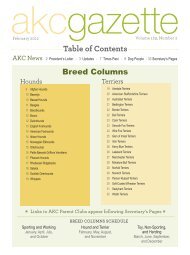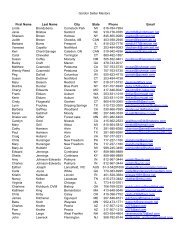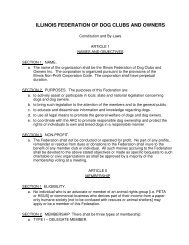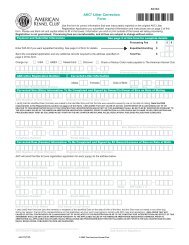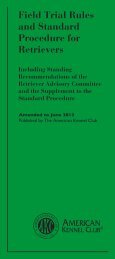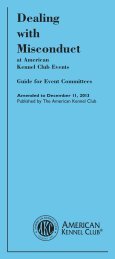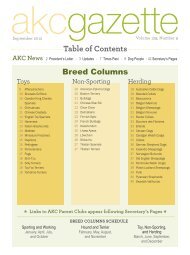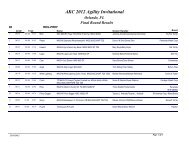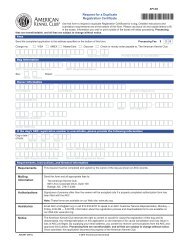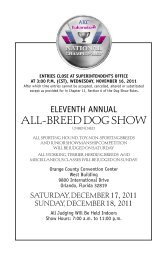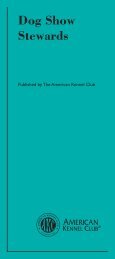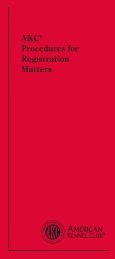Obedience Regulations - American Kennel Club
Obedience Regulations - American Kennel Club
Obedience Regulations - American Kennel Club
You also want an ePaper? Increase the reach of your titles
YUMPU automatically turns print PDFs into web optimized ePapers that Google loves.
that the closer to perfection, the smaller the deduction.<br />
should the dog go out about 20 feet beyond the jumps, stop on command<br />
by the handler and sit in the approximate center of the ring, there<br />
is no deduction. (this is represented by an imaginary circle of about 3<br />
feet in the center of the ring at about a distance of 20 feet beyond the<br />
jumps.) Keep in mind that the handler should stop and sit the dog about<br />
20 feet beyond the jump, not precisely 20 feet beyond the jump. if the<br />
dog stops and sits on the handler’s command at 21 feet or 19 feet beyond<br />
the jumps (this is about 20 feet beyond the jumps), no points should be<br />
deducted. the key is that the dog stops and sits on command. the dog<br />
should not stop and sit without a command from the handler or stop<br />
and/or sit when it arrives at the ring barrier simply because it can go no<br />
further. if the dog does either of these, points are deducted because the<br />
handler’s command did not cause the dog to stop and sit. if the dog stops<br />
and sits on the handler’s command but the handler has stopped the dog<br />
at about the 12-foot distance, a deduction is in order as the handler did<br />
not stop and sit the dog at about 20 feet beyond the jumps. Again, the<br />
requirement is to stop and sit the dog at about 20 feet beyond the jumps,<br />
not precisely 20 feet beyond the jumps.<br />
if the dog goes out about 20 feet beyond the jumps, stops and sits on<br />
the handler’s command but its final position is in one of the corners of<br />
the ring, a three point deduction should be made. if the dog goes out<br />
only 10 feet beyond the jumps, stops and sits on command but the final<br />
position is in the center of the ring, a three point deduction should be<br />
made. if the dog goes out about 10 feet, stops and sits on command but<br />
the final position is next to the side of the ring, a five or six point deduction<br />
is in order.<br />
once the handler has commanded the dog to sit at a point about 20<br />
feet beyond the jumps and the dog stops, the go-out part of the exercise<br />
is complete. A dog must receive a non-qualifying (nQ) score for not<br />
staying without an additional command or signal to sit or the handler<br />
giving a second command to sit. the penalties for the recall will apply.<br />
Group Exercises. if two classes in the same classification such as<br />
novice A and b have different judges, each judge must judge the group<br />
exercises separately. A judge with only a single dog competing in a<br />
class would be required to have the dog perform the group exercises<br />
alone. However, if the same judge is judging both A and b classes (in<br />
the same classification) and the combined two classes do not exceed the<br />
limit of dogs based on the size of the ring, the judge may combine the<br />
two classes for the group exercises.<br />
Judges should make every effort to equally divide a class for the group<br />
exercises and not have fewer than six dogs in the exercise.<br />
in the long Down exercise, the dog should lie down on command<br />
and/or signal without being touched. in the down position, the dog<br />
103<br />
<strong>Obedience</strong> Judges’<br />
Guidelines




